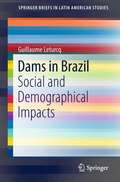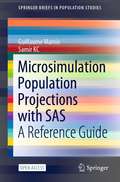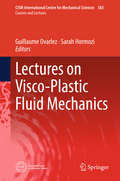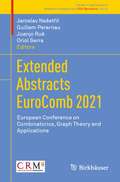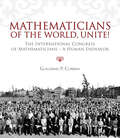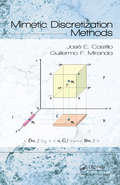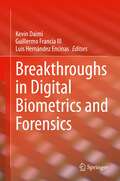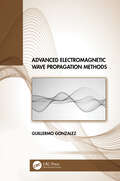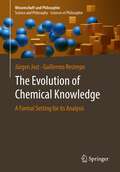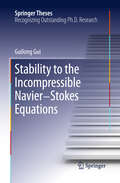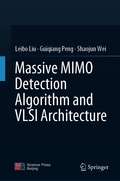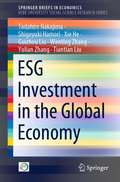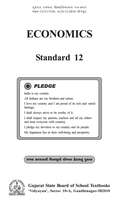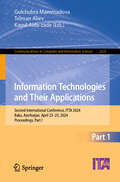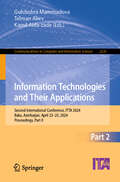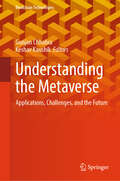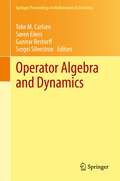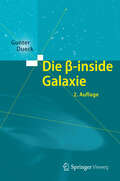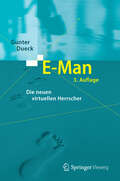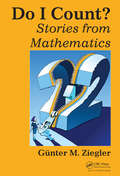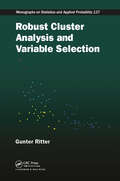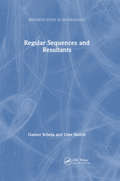- Table View
- List View
Dams in Brazil: Social and Demographical Impacts (SpringerBriefs in Latin American Studies)
by Guillaume LeturcqThe book focuses on the human and social effects of the construction of hydroelectric dams in Brazil. It discusses themes such as forced migrations, how the families of the victims of the dams adapt to new living areas, the struggle of families with the relocation of their homes and the fact that they are neglected by builders and government. These discussions are carried out in a comparative perspective between Southern and Northern Brazil, where contexts and living conditions are quite different. The book's main objective is to analyze the movements, adaptations and life changes in families suffering from the effects of dams throughout Brazil. This is the first book that analyzes the relationship dam-space with the intent to understand how dams affect the territory. The book is organized in three chapters: the dams’ effects in Brazil and the territorial impacts; human and social consequences of dam construction; a regional comparison of the effects of dams between the South and the North of the country.
Microsimulation Population Projections with SAS: A Reference Guide (SpringerBriefs in Population Studies)
by Guillaume Marois Samir KCThis open access book provides a step-by-step overview on how to build a microsimulation model with SAS. It shows how to convert an already existing multistate projection by age, sex, education and region into a microsimulation model. Two new dimensions are then added, either the labor force participation and the sector of activity, and/or some examples of outputs and alternative scenarios that would not be possible with standard demographic methods. The book also describes how to adapt the model for other countries or other purposes. It also provides details on how to extend and adapt the model for other purposes as well as other use of microsimulation with SAS. The book suggests codes that are easy to understand, so they can be replicated or adapted for other purposes. As such, this book provides a great resource for people with beginner to intermediate knowledge in SAS.
Lectures on Visco-Plastic Fluid Mechanics (CISM International Centre for Mechanical Sciences #583)
by Guillaume Ovarlez Sarah HormoziThe book is designed for advanced graduate students as well as postdoctoral researchers across several disciplines (e.g., mathematics, physics and engineering), as it provides them with tools and techniques that are essential in performing research on the flow problems of visco-plastic fluids. The following topics are treated: analysis of classical visco-plastic fluid modelsmathematical modeling of flows of visco-plastic fluidscomputing flows of visco-plastic fluidsrheology of visco-plastic fluids and visco-plastic suspensionsapplication of visco-plastic fluids in engineering sciencescomplex flows of visco-plastic fluids.
Extended Abstracts EuroComb 2021: European Conference on Combinatorics, Graph Theory and Applications (Trends in Mathematics #14)
by Jaroslav Nešetřil Guillem Perarnau Juanjo Rué Oriol SerraThis book collects the extended abstracts of the accepted contributions to EuroComb21. A similar book is published at every edition of EuroComb (every two years since 2001) collecting the most recent advances in combinatorics, graph theory, and related areas. It has a wide audience in the areas, and the papers are used and referenced broadly.
Mathematicians of the World, Unite!: The International Congress of Mathematicians--A Human Endeavor
by Guillermo CurberaThis vividly illustrated history of the International Congress of Mathematicians- a meeting of mathematicians from around the world held roughly every four years- acts as a visual history of the 25 congresses held between 1897 and 2006, as well as a story of changes in the culture of mathematics over the past century. Because the congress is an int
Mimetic Discretization Methods
by Jose E. Castillo Guillermo F. MirandaTo help solve physical and engineering problems, mimetic or compatible algebraic discretization methods employ discrete constructs to mimic the continuous identities and theorems found in vector calculus. Mimetic Discretization Methods focuses on the recent mimetic discretization method co-developed by the first author. Based on the Castillo-Grone operators, this simple mimetic discretization method is invariably valid for spatial dimensions no greater than three. The book also presents a numerical method for obtaining corresponding discrete operators that mimic the continuum differential and flux-integral operators, enabling the same order of accuracy in the interior as well as the domain boundary.After an overview of various mimetic approaches and applications, the text discusses the use of continuum mathematical models as a way to motivate the natural use of mimetic methods. The authors also offer basic numerical analysis material, making the book suitable for a course on numerical methods for solving PDEs. The authors cover mimetic differential operators in one, two, and three dimensions and provide a thorough introduction to object-oriented programming and C++. In addition, they describe how their mimetic methods toolkit (MTK)-available online-can be used for the computational implementation of mimetic discretization methods. The text concludes with the application of mimetic methods to structured nonuniform meshes as well as several case studies.Compiling the authors' many concepts and results developed over the years, this book shows how to obtain a robust numerical solution of PDEs using the mimetic discretization approach. It also helps readers compare alternative methods in the literature.
Breakthroughs in Digital Biometrics and Forensics
by Luis Hernández Encinas Kevin Daimi Guillermo FranciaThis book focuses on a wide range of breakthroughs related to digital biometrics and forensics. The authors introduce the concepts, techniques, methods, approaches and trends needed by cybersecurity specialists and educators for keeping current their biometrics and forensics knowledge. Furthermore, the book provides a glimpse of future directions where biometrics and forensics techniques, policies, applications, and theories are headed. Topics include multimodal biometrics, soft biometrics, mobile biometrics, vehicle biometrics, vehicle forensics, integrity verification of digital content, people identification, biometric-based cybercrime investigation, among others. The book is a rich collection of carefully selected and reviewed manuscripts written by diverse digital biometrics and forensics experts in the listed fields and edited by prominent biometrics and forensics researchers and specialists.
Advanced Electromagnetic Wave Propagation Methods
by Guillermo GonzalezThis textbook provides a solid foundation into many approaches that are used in the analysis of advanced electromagnetic wave propagation problems. The techniques discussed are essential to obtain closed-form solutions or asymptotic solutions and meet an existing need for instructors and students in electromagnetic theory. The book covers various advanced mathematical methods used in the evaluation of the electromagnetic fields in rectangular, cylindrical and spherical geometries. The mathematics of special functions (i.e., Bessel, Hankel, Airy, Legendre, Error, etc.) are covered in depth, including appropriate Appendices. The author takes particular care to provide detailed explanations of auxiliary potentials, Hertz’s vectors, Debye potentials, as well as the use of Green functions, the Watson transformation and the method of steepest descent in the solution of electromagnetic problems. Overall, Advanced Electromagnetic Wave Propagation Methods is a good source for the many skills required in obtaining closed form and asymptotic solution, which in many instances cannot be obtained using computer codes of Maxwell’s equations. Thus, it provides an excellent training for preparing graduate students in their research work. This book is intended for a graduate course in electromagnetic theory for students in electrical engineering. Students in physics and professionals will also find it appropriate and useful. Provides a comprehensive and unified treatment of radiation and propagation problems Presents a detailed explanation in the use of Green functions, the Watson transformation and the method of steepest descent as they apply to electromagnetic problems Demonstrates various advanced mathematical techniques used in the evaluation of the electromagnetic fields Details how to formulate and obtain a closed-form solution or an asymptotic solution Includes appendices for Bessel, Legendre, Airy and Error functions
The Evolution of Chemical Knowledge: A Formal Setting for its Analysis (Wissenschaft und Philosophie – Science and Philosophy – Sciences et Philosophie)
by Jürgen Jost Guillermo RestrepoChemistry shapes and creates the disposition of the world's resources and provides novel substances for the welfare and hazard of our civilisation at an exponential rate. Can we model the evolution of chemical knowledge? This book not only provides a positive answer to the question, it provides the formal models and available data to model chemical knowledge as a complex dynamical system based on the mutual interaction of the social, semiotic and material systems of chemistry. These systems, which have evolved over the history, include the scientists and institutions supporting chemical knowledge (social system); theories, concepts and forms of communication (semiotic system) and the substances, reactions and technologies (material system) central for the chemical practice. These three systems, which have traditionally been mostly studied in isolation, are brought together in this book in a grand historical narrative, on the basis of comprehensive data sets and supplemented by appropriate tools for their formal analysis. We thereby develop a comprehensive picture of the evolution of chemistry, needed for better understanding the past, present and future of chemistry as a discipline. The interdisciplinary character of this book and its non-technical language make it an ideal complement to more traditional material in undergraduate and graduate courses in chemistry, history of science and digital humanities.
Geometric Partial Differential Equations and Image Analysis
by Guillermo SapiroThis book provides an introduction to the use of geometric partial differential equations in image processing and computer vision. It brings a number of new concepts into the field, providing a very fundamental and formal approach to image processing. State-of-the-art practical results in a large number of real problems are achieved with the techniques described. Applications covered include image segmentation, shape analysis, image enhancement, and tracking. The volume provides information for people investigating new solutions to image processing problems as well as for people searching for existent advanced solutions.
Stability to the Incompressible Navier-Stokes Equations
by Guilong GuiThis thesis contains results of Dr. Guilong Gui during his PhD period with the aim to understand incompressible Navier-Stokes equations. It is devoted to the study of the stability to the incompressible Navier-Stokes equations. There is great potential for further theoretical and numerical research in this field. The techniques developed in carrying out this work are expected to be useful for other physical model equations. It is also hopeful that the thesis could serve as a valuable reference on current developments in research topics related to the incompressible Navier-Stokes equations. It was nominated by the Graduate University of Chinese Academy of Sciences as an outstanding PhD thesis.
Massive MIMO Detection Algorithm and VLSI Architecture
by Leibo Liu Shaojun Wei Guiqiang PengThis book introduces readers to a reconfigurable chip architecture for future wireless communication systems, such as 5G and beyond. The proposed architecture perfectly meets the demands for future mobile communication solutions to support different standards, algorithms, and antenna sizes, and to accommodate the evolution of standards and algorithms. It employs massive MIMO detection algorithms, which combine the advantages of low complexity and high parallelism, and can fully meet the requirements for detection accuracy. Further, the architecture is implemented using ASIC, which offers high energy efficiency, high area efficiency and low detection error. After introducing massive MIMO detection algorithms and circuit architectures, the book describes the ASIC implementation for verifying the massive MIMO detection. In turn, it provides detailed information on the proposed reconfigurable architecture: the data path and configuration path for massive MIMO detection algorithms, including the processing unit, interconnections, storage mechanism, configuration information format, and configuration method.
ESG Investment in the Global Economy (SpringerBriefs in Economics)
by Shigeyuki Hamori Wenting Zhang Tadahiro Nakajima Xie He Guizhou Liu Yulian Zhang Tiantian LiuThis book introduces environmental, social and governance (ESG) investment and clarifies its characteristics as financial securities. It is forecasted that companies’ ESG information will be reflected in their corporate value as much as their financial information is in the future. The special feature of this book is to reveal the characteristics and impact of ESG investment using various quantitative analyses (e.g. EGARCH, asymmetric DCC, copula, VaR, connectedness, dynamic spillover). This book focuses on the relationship between some ESG indexes and the other economic variables, particularly in light of the recent economic environment (e.g. Global Financial Crisis, COIVID-19 pandemic, crude oil price crash). Readers can grasp a larger picture of ESG investment through a survey of its history and current status, predictions of its future, and interpretation of various empirical analysis results.
Elements of Accounts Part 2 class 12 - GSTB
by Gujarat Sate Board of School TextbooksThe book published by the Gujarat State Board of Textbooks for class 12 has been written in a simple English language keeping in view the standard of class 12 students. This book will also be of great use to those students who are just beginning to learn the subject of Accountancy. A number of illustrations have been given in each chapter and these have been solved in such a simple manner that students can easily understand them. Practical questions given at the end of each chapter are strictly in the serial order of the illustrations. Answers and hints to solve the questions have been given at the end of each question. We are very much confident that after doing the illustrations, students can themselves solve the practical questions. The book contains essay-type, short-anwer type, objective type and practical questions at the end of each chapter so that students may test their understanding of the chapter.
Economics class 12 - GSTB
by Gujarat State Board of School TextbooksThe Gujarat State Board of School Textbooks takes pleasure in presenting this textbook to the students. It is prepared according to the new syllabus of Economics for Standard 12. This textbook is written and reviewed by expert teachers and professors. This textbook is published after incorporating the necessary changes suggested by the reviewers.
Elements of Accounts Part 1 class 12 - GSTB
by Gujarat State Board of School TextbooksThe Gujarat State Board of School Textbooks takes pleasure in presenting this textbook to the students. It is prepared according to the new syllabus of Elements of Accounts (Part 1) for Standard 12. This textbook is written and reviewed by expert teachers and professors. This textbook is published after incorporating the necessary changes suggested by the reviewers.
Information Technologies and Their Applications: Second International Conference, ITTA 2024, Baku, Azerbaijan, April 23–25, 2024, Proceedings, Part I (Communications in Computer and Information Science #2225)
by Telman Aliev Gulchohra Mammadova Kamil Aida-ZadeThe two-volume set CCIS 2225 and 2226 constitutes the proceedings of the Second International Conference on Information Technologies and Their Applications, ITTA 2024, held in Baku, Azerbaijan, during April 23-25, 2024. The 51 full papers and 9 short papers presented were carefully reviewed and selected from 200 submissions. They were organized in the following topical sections: Part I - information technology in intelligent systems; and information technology in modeling. Part II - information technology applied in construction, industry, and engineering; and information technology in decision making.
Information Technologies and Their Applications: Second International Conference, ITTA 2024, Baku, Azerbaijan, April 23–25, 2024, Proceedings, Part II (Communications in Computer and Information Science #2226)
by Telman Aliev Gulchohra Mammadova Kamil Aida-ZadeThe two-volume set CCIS 2225 and 2226 constitutes the proceedings of the Second International Conference on Information Technologies and Their Applications, ITTA 2024, held in Baku, Azerbaijan, during April 23-25, 2024. The 51 full papers and 9 short papers presented were carefully reviewed and selected from 200 submissions. They were organized in the following topical sections: Part I - information technology in intelligent systems; and information technology in modeling. Part II - information technology applied in construction, industry, and engineering; and information technology in decision making.
Understanding the Metaverse: Applications, Challenges, and the Future (Blockchain Technologies)
by Keshav Kaushik Gunjan ChhabraThis book highlights the numerous potentials and concerns involved with using the metaverse. Furthermore, the project discusses countermeasures to protect any firm from these risks. Insights into practical solutions may assist organizations in using this new business model by raising awareness and preparing them to improve. The book helps readers get insights into technology's future, i.e., the metaverse. The application areas of the metaverse is quite vast, but it also includes security and privacy issues. Addressing the security issues is the need of the hour. Developers are designing the applications, and users are ready to use them, but on the other side, many security issues need to be focused on. Hence, along with the applications, this book helps the reader understand these hidden security and privacy issues.
Operator Algebra and Dynamics
by Toke M. Carlsen Søren Eilers Gunnar Restorff Sergei SilvestrovBased on presentations given at the NordForsk Network Closing Conference "Operator Algebra and Dynamics," held in Gjáargarður, Faroe Islands, in May 2012, this book features high quality research contributions and review articles by researchers associated with the NordForsk network and leading experts that explore the fundamental role of operator algebras and dynamical systems in mathematics with possible applications to physics, engineering and computer science. It covers the following topics: von Neumann algebras arising from discrete measured groupoids, purely infinite Cuntz-Krieger algebras, filtered K-theory over finite topological spaces, C*-algebras associated to shift spaces (or subshifts), graph C*-algebras, irrational extended rotation algebras that are shown to be C*-alloys, free probability, renewal systems, the Grothendieck Theorem for jointly completely bounded bilinear forms on C*-algebras, Cuntz-Li algebras associated with the a-adic numbers, crossed products of injective endomorphisms (the so-called Stacey crossed products), the interplay between dynamical systems, operator algebras and wavelets on fractals, C*-completions of the Hecke algebra of a Hecke pair, semiprojective C*-algebras, and the topological dimension of type I C*-algebras. Operator Algebra and Dynamics will serve as a useful resource for a broad spectrum of researchers and students in mathematics, physics, and engineering.
Die beta-inside Galaxie
by Gunter DueckAlpha-Versionen sind Lehrbücher, Gesetze, Hochglanzprospekte, Aktienneuemissionsanzeigen, Regierungserklärungen. Dahinter ist das Reale. Hinter den Lehrbüchern die vorlesende Forscherpersönlichkeit, hinter dem Prospekt der Rat des erfahrenen Fachverkäufers. Alpha-Versionen meiden Urteile, Meinungen und Leidenschaftlichkeit. Dieses Buch ist kompromisslos beta. Hier werden die schnellen Veränderungen der Informationsgesellschaft mit dem einhergehenden täglichen Wahnsinn aus möglichen und unmöglichen Perspektiven aufs Korn genommen - und wo es nicht anders geht, wird das zu arg Provozierende in Schwarzhumorsatire genießbar gemacht ("Nicht nur zur Neujahrszeit" oder "Das Ende der DGeneration").Das Buch enthält die bisherigen Texte der "Kult"-Kolumne Beta-inside (Informatik-Spektrum) des "Wild Duck" Autors, ergänzt um Satiren, die eher "das Schönste" am Buche sind. Die Neuauflage wurde um ein Nachwort des Autors erweitert.
E-Man
by Gunter DueckDie Haupteigenschaften des in der Wirtschaft "ausschlaggebenden" Menschen werden sich ändern. Wir verlassen die "Bauerngesellschaft" der ruhigen, pflichttreuen Menschen, die Tradition, Erfahrung und Orndung herrschen lassen (Old Economy). die neue Zeit "kämpft" mit neuen Geschäftsmodellen und immer schnelleren Technologiezyklen um die Milliarden, die der Erste im Markt erringen kann. Keine Zeit mehr für Erfahrung & Co. Wie wird das sein - in E-Man's World? Besser? Mit 40 Millionär oder Burnout? Wie lange tobt der Umbruch? E-Man muss vor allem kreativ, proaktiv, authentisch, erneuerungs- und risikofähig sein, voller Verrtrauen im stärksten Wandel. Ein Bericht aus der Turbulenzzone des Managements und des Innermenschlichen. Wie gewohnt spannend, provokativ, streitbar und leidenschaftlich subjektiv! Die dritte Auflage wurde um ein Nachwort des Autors ergänzt.
Do I Count?: Stories from Mathematics (AK Peters/CRC Recreational Mathematics Series)
by Gunter M. ZieglerThe subject of mathematics is not something distant, strange, and abstract that you can only learn about-and often dislike-in school. It is in everyday situations, such as housekeeping, communications, traffic, and weather reports. Taking you on a trip into the world of mathematics, Do I Count? Stories from Mathematics describes in a clear and capt
Robust Cluster Analysis and Variable Selection (ISSN)
by Gunter RitterClustering remains a vibrant area of research in statistics. Although there are many books on this topic, there are relatively few that are well founded in the theoretical aspects. In Robust Cluster Analysis and Variable Selection, Gunter Ritter presents an overview of the theory and applications of probabilistic clustering and variable selection,
Regular Sequences and Resultants
by Uwe Storch Gunter SchejaThis carefully prepared manuscript presents elimination theory in weighted projective spaces over arbitrary noetherian commutative base rings. Elimination theory is a classical topic in commutative algebra and algebraic geometry, and it has become of renewed importance recently in the context of applied and computational algebra. This monograph pro
